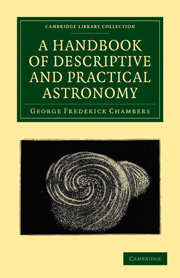Book contents
- Frontmatter
- PREFACE
- SUPPLEMENT
- Contents
- LIST OF ILLUSTRATIONS
- PRINCIPAL AUTHORITIES
- Errata
- A Handbook of Descriptive and Practical Astronomy
- BOOK I A SKETCH OF THE SOLAR SYSTEM
- BOOK II ECLIPSES AND THEIR ASSOCIATED PHENOMENA
- CHAPTER I GENERAL OUTLINES
- CHAPTER II ECLIPSES OF THE SUN
- CHAPTER III THE TOTAL ECLIPSE OF THE SUN OF JULY 28, 1851
- CHAPTER IV THE ANNULAR ECLIPSE OF THE SUN OF MARCH 14–15. 1858
- CHAPTER V THE TOTAL ECLIPSE OF THE SUN OF JULY 18, 1860
- CHAPTER VI HISTORICAL NOTICES
- CHAPTER VII ECLIPSES OF THE MOON
- CHAPTER VIII SUGGESTIONS FOR OBSERVING ANNULAR ECLIPSES OF THE SUN
- CHAPTER IX TRANSITS OF THE INFERIOR PLANETS
- BOOK III THE TIDES
- BOOK IV MISCELLANEOUS ASTRONOMICAL PHENOMENA
- BOOK V COMETS
- BOOK VI CHRONOLOGICAL ASTRONOMY
- BOOK VII THE STARRY HEAVENS
- CHAPTER I
- Chapter II DOUBLE STARS, ETC.
- CHAPTER III
- CHAPTER IV CLUSTERS AND NEBULÆ
- CHAPTER V THE MILKY WAY
- CHAPTER VI THE CONSTELLATIONS
- BOOK VIII ASTRONOMICAL INSTRUMENTS
- BOOK IX A SKETCH OF THE HISTORY OF ASTRONOMY
- BOOK X METEORIC ASTRONOMY
- APPENDICES
- INDEX TO SUBJECTS
- INDEX TO NAMES
- Plate section
- Frontmatter
- PREFACE
- SUPPLEMENT
- Contents
- LIST OF ILLUSTRATIONS
- PRINCIPAL AUTHORITIES
- Errata
- A Handbook of Descriptive and Practical Astronomy
- BOOK I A SKETCH OF THE SOLAR SYSTEM
- BOOK II ECLIPSES AND THEIR ASSOCIATED PHENOMENA
- CHAPTER I GENERAL OUTLINES
- CHAPTER II ECLIPSES OF THE SUN
- CHAPTER III THE TOTAL ECLIPSE OF THE SUN OF JULY 28, 1851
- CHAPTER IV THE ANNULAR ECLIPSE OF THE SUN OF MARCH 14–15. 1858
- CHAPTER V THE TOTAL ECLIPSE OF THE SUN OF JULY 18, 1860
- CHAPTER VI HISTORICAL NOTICES
- CHAPTER VII ECLIPSES OF THE MOON
- CHAPTER VIII SUGGESTIONS FOR OBSERVING ANNULAR ECLIPSES OF THE SUN
- CHAPTER IX TRANSITS OF THE INFERIOR PLANETS
- BOOK III THE TIDES
- BOOK IV MISCELLANEOUS ASTRONOMICAL PHENOMENA
- BOOK V COMETS
- BOOK VI CHRONOLOGICAL ASTRONOMY
- BOOK VII THE STARRY HEAVENS
- CHAPTER I
- Chapter II DOUBLE STARS, ETC.
- CHAPTER III
- CHAPTER IV CLUSTERS AND NEBULÆ
- CHAPTER V THE MILKY WAY
- CHAPTER VI THE CONSTELLATIONS
- BOOK VIII ASTRONOMICAL INSTRUMENTS
- BOOK IX A SKETCH OF THE HISTORY OF ASTRONOMY
- BOOK X METEORIC ASTRONOMY
- APPENDICES
- INDEX TO SUBJECTS
- INDEX TO NAMES
- Plate section
Summary
If, on some clear evening, the reader will take the trouble to station himself on the summit of any rising ground, and cast his eye upwards, he will see the sky spangled with countless multitudes of brilliant specks of light; these are the fixed stars (we shall presently see that this appellation is not strictly correct); an attentive observer will soon notice, also, that the stars he is contemplating seem to revolve in a body around one of their number situated in the north, about midway between the horizon and the zenith; this is the Pole-star, so called from its being near the pole of the celestial equator. On account, however, of the precession of the equinoxes, the present Pole-star (α Ursæ Minoris) will not always be so; the true pole is now about from this star; this distance will be gradually diminished until it is reduced to about half a degree; it will then increase again, and after the lapse of a long period of time, the pole will depart from this star, which will then cease to bear the name or serve the purposes of a Pole-star. 3,970 years ago, the star γ in the constellation Draco fulfilled this office; 12,000 years hence, it will fall to the lot of a brilliant star of the 1st magnitude — Vega (α Lyræ) — which is 24° 52' from the pole.
- Type
- Chapter
- Information
- A Handbook of Descriptive and Practical Astronomy , pp. 269 - 281Publisher: Cambridge University PressPrint publication year: 2010First published in: 1861

